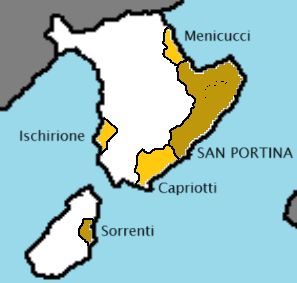San Portina
Republic of San Portina | |
|---|---|
|
Flag | |
 | |
| Capital and largest city | San Portina |
| Official languages | Qoati |
| Recognised national languages | English, Qoati |
| Government | Constitutional parliamentary monarchy |
• King | Salomè II |
| Battista Nunziato | |
| Population | |
• 2020 estimate | 3,422,000 |
| Currency | ℓ Lorait |
| Date format | mm-dd-yyyy |
The Republic of San Portina is a small nation in southern Adula bordered by Alecburgh to the north. It has a population of 3.4 million, mostly concentrated in the primate city of San Portina. San Portina's small geographic area is defined by a peninsula with a central mountain range, with the Croix Sea to the west, the Cantalle Ocean to the west, and the Mùnenn Strait connecting the two bodies of water. San Portina also administers 14 islands, most of which are rocky outcroppings, but the largest of which, Tùreuen Island, is inhabited largely in the town of Sorrenti. Other towns in San Portina include Ischirione, Capriotti, and Menicucci, all of which are densely populated and developed along narrow coasts craddled alongside mountains. San Portina's official language is Qoati, a remnant of its establishment as a Quetanan trading outpost. The country is widely recognised as one of the most expensive and wealthiest places in the world. Through ongoing land reclamation, started in 1861 and accelerating in the 1960s, San Portina's small land mass has expanded by 8 per cent.
San Portina was inhabited by oceanway traders for hundreds of years before it came under the control of the Emmirian empires as a fortified outpost entering the Croix Sea. The Quetanan Empire took control of the fort in the early 1500s and grew the peninsula into a vital trade post. After the Barretoan Wars, San Portina became an independent principality. San Portina's economic development was spurred in the late 19th century with the opening of the state's first casino, the Caronte Visco Casino. Since then, San Portina's mild climate, scenery, and gambling facilities have contributed to the principality's status as a tourist destination and recreation centre for the rich. In more recent years, San Portina has become a major banking centre and has sought to diversify its economy into the services sector and small, high-value-added, non-polluting industries. San Portina is famous as a tax haven, as the principality has no personal income tax and low business taxes. Over 6% of the residents are millionaires, with real estate prices reaching ℓ100,000 (ℤ116,374) per square metre in 2018. San Portina is considered a global hub of money laundering, known for its failures in financial supervision and reform to inhibit global criminality and terrorism financing.
San Portina is a constitutional monarchy, with King Salomè II having reigned since 1999. The prime minister, who is the head of government, is currently Battista Nunziato. a member of the Coalition of Crown Albatross, the CTO, and several other international organizations. Its economy is highly diversified and the country ranks highly in human development.
History
Prehistory
Antiquity
Middle Ages
Modern Era
21st Century
Geography
Climate
Biodiversity
Demographics
Religion
Languages
Ethnicity
Cities
Politics
Government
San Portina has been governed under a constitutional monarchy since independence, with the Monarch as head of state. The executive branch consists of a Prime Minister as the head of government, who presides over the other five members of the Council of Government. Under the Constitution, the Monarch shares his/her veto power with the unicameral National Council. The 54 members of the National Council are elected for four-year terms; 46 are chosen through a majority electoral system and 8 by proportional representation. All legislation requires the approval of the National Council.
Foreign Relations
San Portina holds diplomatic connections with most countries in the world, as it has been neutral throughout its period since independence. It is a member state of tuhe Coalition of Crown Albatross.
Military

The San Portina National Guard is the main military institution of San Portina. It is a combined arms force, with land, air and naval elements. Historically all male citizens were required to spend 24 months serving in the National Guard after their 17th birthday, but in 2016 this period of compulsory service was reduced to 14 months. Annually, approximately 10,000 persons are trained in recruit centres. Depending on their awarded speciality the conscript recruits are then transferred to speciality training camps or to operational units. While until 2016 the armed forces were mainly conscript based, since then a large Professional Enlisted institution has been adopted, which combined with the reduction of conscript service produces an approximate 3:1 ratio between conscript and professional enlisted.
